Harvesting Kiwi Fruit: How And When To Harvest Kiwis
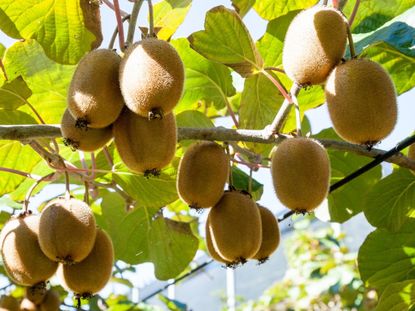

Kiwi fruit (Actinidia deliciosa), otherwise known as Chinese gooseberry, is a large--up to 30 feet (9 m.)--woody, deciduous vine native to China. There are primarily two types of kiwi fruit grown for production: Hardy and Golden. The fruit itself is a lovely green with tiny uniform and edible black seeds inside the fuzzy brown skin, which is removed before eating. This subtropical fruit adapts well in USDA zones 8 through 10. One mature kiwi plants may yield up to 50 pounds or more of fruit after an eight to twelve year period. Knowing when to harvest kiwis can be a bit tricky. Commercial kiwi growers use a tool called a refractometer, which measures the amount of sugar in the fruit to determine the time of a kiwi fruit harvest. The refractometer is a bit pricey (about $150) for most casual kiwi home growers, so another method to determine when to harvest kiwis is in order.
When and How to Pick a Kiwi
So what, as the home gardener, do we need to know in how to pick a kiwi when it is ready? Since we do not have a refractometer to determine when sugar content is optimal (about 6.5 percent or greater), we may rely on the knowledge of when the kiwi fruit is generally mature enough for kiwi fruit harvest. Kiwi fruit has attained full size in August, however, it is not mature enough for kiwi harvesting until late October to early November when the seeds have turned black and the sugar content has risen. Although fruit will soften off the vine after the sugar content is four percent, the sweet flavor has not developed until the content increases to six to eight percent. After kiwi harvesting, the starch is converted to sugar and will then be ready to eat once the fruit contains an astonishing 12 to 15 percent sugar. Vine ripened kiwi has the best flavor but does not store well when ripe. Commercial kiwi harvesting occurs all at once, but the home gardener may very well be harvesting kiwi sporadically beginning in late September. Softness of the kiwi fruit is not always the best indicator of readiness. Unlike some other fruits, kiwi ripens after it has been removed from the vine. When harvesting kiwi handle with care, as they bruise easily and damaged fruit has a limited storage life. To harvest kiwi, snap the stem at the base of the fruit. Again, softness is not a great determiner for readiness. Size, date, and when in doubt, cut open a fruit to access the seeds inside-- when seeds are black, it is time for kiwi fruit harvest. Remove the larger fruit when harvesting kiwi and allow the smaller to remain on the vine and attain some size.
Information on Kiwi Storage
Kiwi storage can last some time-- up to four to six months at 31 to 32 degrees F. (-5-0 C.), provided the fruit is kept chilled and away from other ripe fruit, which gives off ethylene gas and may hasten the demise of the ripening kiwis. To store kiwi, chill the fruit as soon as possible after picking and store at a high humidity. The colder the temperature for kiwi storage, the longer the kiwis keep. For kiwi storage lasting up to two months, pick the fruit while they are still hard and store immediately in the refrigerator in a vented plastic bag. To ripen the kiwi fruit, remove them from the fridge and place them in a vented plastic bag with an apple or banana at room temperature to hasten ripening. They will also ripen on their own at room temp, it will just take a little longer. The kiwi will be ripe and ready to eat once it is soft to the touch. Eat immediately, as soft kiwi does not last very long.
Gardening tips, videos, info and more delivered right to your inbox!
Sign up for the Gardening Know How newsletter today and receive a free download of our most popular eBook "How to Grow Delicious Tomatoes."

Amy Grant has been gardening for 30 years and writing for 15. A professional chef and caterer, Amy's area of expertise is culinary gardening.
-
 Monkey Orchid Care: How To Grow This Fascinating Species
Monkey Orchid Care: How To Grow This Fascinating SpeciesThe monkey orchid bears a remarkable resemblance to its namesake and, with a little know-how, can be successfully grown as a houseplant.
By Bonnie L. Grant
-
 How To Grow Garden To Table: A Guide For Home Cooks
How To Grow Garden To Table: A Guide For Home CooksWhat could be better than a meal that comes directly from garden to table? Show off your gardening and culinary skills with the very freshest food.
By Bonnie L. Grant
-
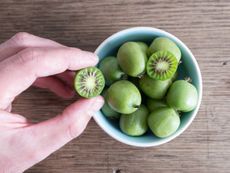 Kiwiberry Care Guide – Learn About Kiwiberry Growing Conditions
Kiwiberry Care Guide – Learn About Kiwiberry Growing ConditionsLove kiwis but wish they didn't have the fuzzy, gritty skin? Enter the kiwiberry. Read on for more info about these weird little fruits.
By Bonnie L. Grant
-
Caring For Kiwi: How To Grow Hardy Red Kiwi Fruit
Hardy Red kiwi produces grape-sized, fuzz-less fruit with an authentic kiwi flavor. For information on growing them, click the following article.
By Laura Miller
-
 Tricolor Kiwi Information: How To Grow A Tricolor Kiwi Plant
Tricolor Kiwi Information: How To Grow A Tricolor Kiwi PlantActinidia kolomikta is a hardy kiwi vine that is commonly known as tricolor kiwi plant because of its variegated foliage. Also known as arctic kiwi, it is one of the hardiest of the kiwi vines. For tips on growing tricolor kiwi, click this article.
By Darcy Larum
-
 Kiwi Plant Trimming: Pruning Mature Kiwi Vines In The Garden
Kiwi Plant Trimming: Pruning Mature Kiwi Vines In The GardenRegular pruning is an essential part of caring for kiwi vines. Kiwi vines left to their own devices quickly become a tangled mess. But pruning overgrown kiwi vines is also possible if you follow simple trimming steps. This article will help.
By Teo Spengler
-
 Fruit Companion Planting: Companion Planting Around Kiwi Vines
Fruit Companion Planting: Companion Planting Around Kiwi VinesCompanions for kiwi can help the plants grow more vigorously and fruit more prolifically. Not every plant is an ideal kiwi companion plants, though. What plants make the most ideal kiwi plant companions? Click this article to learn more.
By Amy Grant
-
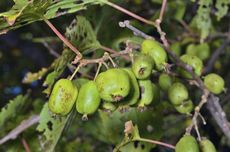 Hardy Kiwi Diseases: How To Treat A Sick Kiwi Plant
Hardy Kiwi Diseases: How To Treat A Sick Kiwi PlantWhile the kiwi plant is tough and relatively easy to grow, it can fall prey to various kiwi plant diseases. You can learn more about the diseases of kiwi and their treatment in this article. Click here for more information.
By Mary H. Dyer
-
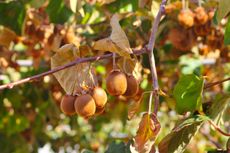 Kiwi Leaves Turn Brown – Reasons For Kiwi Vines Turning Yellow Or Brown
Kiwi Leaves Turn Brown – Reasons For Kiwi Vines Turning Yellow Or BrownHealthy kiwi leaves are a brilliant green during the growing season, and you might well become worried when your kiwi leaves turn brown or you see yellowing kiwi plants. Click this article for information about steps to take when you see kiwi leaves turning yellow.
By Teo Spengler
-
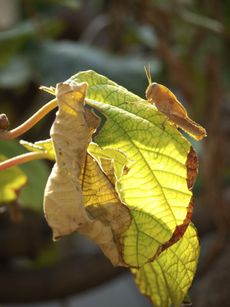 Pests Of Kiwi Vines: Information For Treating Kiwi Bugs
Pests Of Kiwi Vines: Information For Treating Kiwi BugsWhile kiwi plants are tough and relatively easy to grow, they can fall prey to various kiwi plant pests. Learn more about kiwi insects and tips for treating kiwi bugs in this article. Click here for additional information.
By Mary H. Dyer